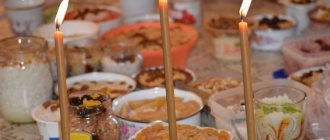What do you prepare for a funeral at home?
- Kutya,
- pancakes,
- pies,
- drinks: uzvar, jelly.
- What else to cook?
- Lenten commemoration.
- Recipes.
The place at the funeral table where the deceased usually sat is left unoccupied. A symbolic glass of vodka and a slice of black bread and the deceased’s favorite dish are placed there. Near the photo of the deceased, you can place a QR code for an obituary or memory page.
What is the Orthodox funeral tradition?
The first time the deceased is remembered is on the third day after death, when, according to Orthodox beliefs, the soul ascends to God. The second time, relatives and friends gather for commemoration after nine days, so that the soul, seeing the torment of Hell, repents of its sins and receives hope for mercy and forgiveness. Prayers of relatives on the fortieth day help the soul of the deceased to pass the most important test - the highest court, whose verdict can mean eternal bliss in heaven or endless torment of hell.
Funerals on certain days have been a traditional custom since ancient times. After the burial, having returned from the cemetery and having washed the hands and body, the soul of the deceased is seen off with a wake. The third day is the period when separation from everything earthly and ascension to the heavenly throne occurs. It doesn’t matter where loved ones will gather, whether it’s a home event or an organized meal in a cafe. It is important to remember that a wake is a ritual of mourning for the newly deceased, and therefore should be accompanied by prayer, and not by drinking alcoholic beverages and loud conversations.
The restrained behavior at wakes after funerals and on other days is echoed by the menu. Signs of a feast are not acceptable, but laconic table decoration and a reasonable variety of prepared dishes are appropriate.
Serving and selection of dishes
Before dwelling on the choice of dishes, you should pay attention to the table setting. Everyone knows about maintaining a mournful and mournful atmosphere. However, some are not aware of the existing rules that it is advisable to follow:
- Dishes intended for holidays and ceremonial receptions are not placed on the funeral table. They eat from those cutlery that are used in everyday life;
- the tablecloth should not have ornaments or colorful inclusions that will distract from thoughts and prayers;
- If you organize a funeral meal with the most complete observance of traditions, then you should do without forks and knives. Our ancestors tried to avoid the use of any piercing objects, which, according to them, could pose a danger to the body of the deceased.
A simple and strict funeral table is one of the requirements for organizing a wake. The menu consists of simple and nutritious dishes that are useful on ordinary days, and during periods of grief will give strength to endure the loss.
Pancakes
The funeral table after the burial, as well as the snack immediately after the funeral in the cemetery, should consist of simple dishes that satiate people weakened by grief. What is hearty and nutritious to prepare for a funeral? Russian pancakes with filling.
Bake thin pancakes with holes in which you wrap a delicious filling - overcooked minced meat with onions, cottage cheese, chopped boiled egg with green onions. Use only fresh ingredients and thoroughly washed dishes. To bake pancake dough, use a separate frying pan or pancake maker.
Due to the combination of milk and kefir fermentation, voids appear in the dough in the form of bubbles of carbon dioxide, which form holes when the dough is heated in a frying pan. The finished pancakes turn out delicate, thin, and appetizing.
Ingredients:
- premium sifted flour – 360 g
- kefir - 150 ml;
- milk with fat content 2.5 – 370 ml;
- salt - to taste;
- eggs category 0 – 2 pcs.;
- sour cream 15% -65 ml;
- sugar - to taste;
- refined oil – 30 ml
Cooking process:
In a large, thoroughly washed bowl using a mixer, mix heated milk, eggs, sour cream, sugar, salt, kefir. Pass the flour through the sieve again and stir evenly with the baking powder. Add the bulk ingredient in a thin stream and stir with a fork or blender to prevent the formation of lumps. Bake over medium heat. Once the pancakes have cooled slightly, wrap the filling in them.
What should be on the funeral table
Products for preparation are carefully selected, paying attention to quality and freshness. Familiar, familiar food according to traditional family recipes and a quiet conversation dedicated to the memories of the deceased person - this is what an Orthodox commemoration ideally represents.
If you prepare it yourself, it will not be burdensome to cook borscht, prepare a vegetable salad, or serve boiled potatoes or dumplings with cabbage to commemorate the deceased. On ordinary days, cutlets are suitable as a meat dish. It's hard to imagine a funeral dinner without baked pies. The most common drinks are jelly and compote. In addition to the above food, sliced sausage, cheese, fresh vegetables or fruits can be served at the funeral. They eat industrially processed fish or fried fish at home, and include sandwiches on the menu at the discretion of relatives.
What dishes must be prepared after the funeral and for the next wake?
The menu of a funeral dinner, organized in accordance with the canons of the Orthodox faith, must include several dishes. Each of them carries a certain semantic load and is symbolically associated with the movement of the soul of the deceased to a new state.
Kutya for the memorial day is prepared only from whole grains. Most often, a mixture of wheat and rice is taken, soaked for several hours and boiled until the consistency of soft grains. The kutya is flavored with poppy seeds and crushed nuts. The sweetness of spiritual peace in the heavenly kingdom is intended to be demonstrated by the addition of honey and raisins. Resurrection and eternal life are symbolized by the grains in kutya. It matters not only whether the dishes must be present at the funeral table, but also in what order they are served. Kutya is placed on the table first. Each guest taking part in the meal eats a handful of kutia and then continues the meal.
Why do funerals take place and how important are they?
The tradition of holding a posthumous meal has come to us from time immemorial. The pagan tribes that inhabited the territory of the modern Russian state held funerals on a large scale. If one of the elders died, everything that could be useful in the afterlife was placed in his grave. Often all kinds of food were brought to the burial site.
During the time of the first Russian princes, funeral traditions changed. The deceased were now buried under mounds, and a magnificent feast was held in their honor - a funeral feast. It is believed that these meals became the prototype of modern funerals.
With the passage of time and the change of eras, the tradition of the funeral meal has undergone numerous changes. New rules and rituals appeared.
Calling a ritual agent
city funeral service
Funeral arrangements
in St. Petersburg and the region
Cemeteries of St. Petersburg
detailed information
An important role was given to dishes in the funeral menu. Of particular importance was their composition, the sequence of presentation and observance of the ceremony. Echoes of existing traditions can still be found today. The rules according to which the funeral table is set have existed for centuries.
The wake is an important part of the funeral. While guests share memories of moments in their lives associated with the deceased, his image seems to be in the air. However, a memorial meal is held not only to honor the memory of the deceased. The support of relatives and friends helps the family of the deceased to quickly accept their grief and alleviate mental anguish.
Drinks on the funeral table menu
The modern way of remembering with alcohol is not only not welcomed by the church, but is also strictly prohibited for people who know about the symbolism of alcohol on the table on the day of the funeral and traditional memorial dates, including six months and the anniversary.
Those who truly want the soul of the deceased to reach heaven at the memorial do not drink alcohol. Any guest, from a close relative to a work friend or housemate, should understand that alcohol aggravates the torment of the soul of the deceased. Our Orthodox ancestors believed that including alcohol in the funeral menu was a wish for the deceased to suffer severe torment on the way to the gates of Heaven. Close people are invited and treated, setting the table with the obligatory funeral dishes and supplementing them with food at their discretion, but pouring vodka or wine will be an impious act.
It is customary to serve berry juice and prepare lemonade according to your favorite recipe. You can use store-bought juice, but homemade compote will be incomparably better. It’s easy to prepare a funeral service using dried fruits. A good housewife always has the necessary ingredients at hand; they can be freely purchased at any time of the year. For a five to seven liter pan use:
- 0.5 kg dried apples;
- 0.5 kg of whole or chopped dried pears;
- 1 glass of sugar, and it is not necessary to make the uzvar sweet.
To prepare, pour water into a saucepan of sufficient volume, put it on the fire, and while the water boils, wash the dried fruits. Place apples and pears in boiling water, and when the uzvar simmers over low heat for about half an hour, you can add sugar. When using honey, you must first cool the liquid to room temperature. The finished uzvar is allowed to brew for several hours.
It should be understood that many healthy non-alcoholic drinks can serve as an alternative to wine and vodka. They are more appropriate in everyday life, and even more so on a mournful occasion with its strict restrictions.
Funeral kutia recipe
Required ingredients:
- 2 tbsp white rice;
- 4 tbsp drinking water;
- a pinch of salt;
- 150 g raisins;
- 3 tbsp. honey;
- 100 g raspberries, strawberries;
- 0.5 l of water;
- 2 tbsp. Sahara.
Cooking method:
First you need to boil the rice. To do this, rinse the cereal thoroughly. Then fill it with 4 glasses of water, put it on medium heat and add a little salt. Cook the porridge until crumbly.
While the rice is cooking, you need to cook the compote, which we will pour over it after the kutya. To do this, bring 0.5 liters of water to a boil, add pre-washed berries and sugar. Cook for a few minutes. Set the compote aside to cool.
The raisins must be washed and doused with boiling water to make them softer.
So, all the ingredients are ready, you can combine them.
Pour the cooled rice into a deep bowl, add honey, garnish with raisins and pour over sweet compote.
Based on the above recipe, you can prepare kutia from wheat or barley. Nuts and poppy seeds are also added to this dish.
What to commemorate in Lent
The passing of a loved one can happen during the period of fasting. Relatives cannot cancel their duty both on the ninth and fortieth day after death for the sole reason that ordinary dishes cannot be prepared.
During Lent, the deceased is remembered in accordance with the traditions of Orthodox spiritual culture, but adjustments are made by excluding certain ingredients that are not eaten at this time.
The menu for a memorial lunch during Lent is special. Kutya is prepared without adding butter. Water is added to the pancake batter instead of milk and no eggs are added. The rest of the treats can also be prepared Lenten and a ritual meal can be organized at a decent level.
Main courses should not contain meat, but can be no less tasty if you select the right products and follow the cooking technology. From generation to generation, housewives pass on the recipe for the original Russian Lenten borscht, which, according to Orthodox tradition, is quite appropriate for commemorating the dead. No less popular are cabbage soup with mushrooms, buckwheat and sauerkraut. You can prepare vegetable salads, seasoning them with vegetable oil; serve lean cabbage rolls or stuffed peppers with mushroom sauce or carrot meatballs as a side dish of potatoes. Guests will enjoy cabbage pie, pies stuffed with potatoes, onions and herbs, and fruit slices.
When preparing a menu, the most important rule is to maintain restraint and modesty. Those who plan a luxurious meal with alcoholic drinks do not fully understand the meaning of the commemoration. The deceased needs the prayers and remembrance of loved ones more to ease the transition to the afterlife than a funeral dinner with plenty of food and drink. Maybe that’s why no one is invited for 9 days, but those who come are sure to be seated at the table and treated to food.
Features of the mournful table for 9 days
Nine days after death, relatives and friends come themselves; the relatives of the deceased should only be informed when and where, according to Orthodox tradition, everyone can gather to pray for the soul of the deceased.
The menu consists of simple treats that can be prepared at home without taking much time or effort. At uninvited funerals, it is especially not recommended to indulge in gluttony, since the very point is to come without warning, thereby showing that the deceased is remembered. In gratitude, relatives treat guests to whatever is in the house. Modesty is not a sign of poverty. This is how the relatives make it clear to those gathered that the best help for the deceased is prayer, and not a hearty meal.
After traditional prayer in church, a consecrated kutya is brought home for 9 days. Guests are treated to it at the beginning, and only then are they served the dishes that the deceased loved during his lifetime. For hot dishes, you can make borscht, noodles or cabbage soup. The second is replaced with modest snacks, keeping in mind the peculiarity of guests arriving for 9 days without an invitation. As for drinks, unsweetened compote would be the best option.
There should be no alcohol on the table at a wake. The purpose of the meal is somewhat different, and the dishes are prepared more modestly than for a wake on the day of the funeral. Supporting oneself with nourishing food in a moment of grief is replaced by quiet remembrance of the departed person over modest dishes. The food is prepared so that what is left can be divided among those who came at the end of the meal. On this date, no speeches are made, no bad words are said about the deceased, since criticism and negative memories accelerate the movement of his soul towards hell, which begins on the ninth day and reaches a critical point on the fortieth day.
Is it possible to drink alcohol?
Despite the fact that vodka is considered a traditional component of the funeral table, the Orthodox Church is categorically against it. After all, prayer, which is the main purpose of the meal, cannot be compatible with being drunk. Orthodox canons also prohibit placing a filled glass with bread near a photograph of the deceased. However, of course, whether to serve wine and vodka to guests or not is up to the hosts to decide.
If for some reason you do not have the opportunity to cook on your own, then you can easily order a funeral service in a cafe, having previously discussed the menu and the design of the hall with the waiters.
How to commemorate on 40 days and anniversaries
Traditionally, the funeral meal forty days after death was the most important. The special responsibility placed on relatives is to support, through remembrance and prayer, the soul of the deceased, which, according to Orthodox canons, will have to learn the decision regarding the place of further eternal residence. On the fortieth day, the soul ends its journey between earth and heaven, and appears before the judgment of God. For the last time on earth, she bids farewell to the mortal world. Kind words spoken in memory of a person, a prayer asking for forgiveness of sins, contributes to the soul of the deceased entering Paradise and eternal bliss. The most important thing that they do is pray, order Divine Liturgies and participate in funeral services. This is done after six months, and then a year after death.
On the forties, guests are gathered at the deceased’s house. Restraint and conciseness are observed in table setting and interior decoration. They remember that wakes cannot be turned into ordinary gatherings with gluttony and alcoholic libations. At funerals they eat:
- obligatory kutya and pancakes. They follow the serving sequence and eat the dishes in the established sequence, remembering their symbolic meaning: the grains will fall into the ground, germinate next year, and this will be the beginning of a new life. Eating pancakes, a semblance of the sun reborn, will give relatives hope for the resurrection of the soul of the deceased;
- After a traditional hot dish, you are supposed to serve meat or fried fish with a side dish in the form of porridge or mashed potatoes. You can add cold appetizers, herring, meat and vegetable cuts to the menu;
- salads at funerals are mostly lean: vinaigrette with beans and mushrooms, cucumbers and tomatoes, cabbage salad, carrots or boiled beets with prunes;
- jelly, compote or uzvar are placed on the table at the beginning of the meal, and at the end of the funeral dinner, oven-baked pies are served, which those present eat and take with them.
The remaining dishes of the funeral meal on fortieth, six months and anniversaries are distributed to neighbors and acquaintances who were not at the funeral.
In the modern world, one can observe how customs are erased and become a thing of the past. However, the Orthodox tradition of commemorating the dead is honored in every family.
Magpies and their meaning in culture
However, it would be wrong to say that the forties acquired any sacred significance only with the Christianization of the Slavs. Even in the pre-Christian era, they were the main date of private commemoration and its final stage, after which only the commemoration of the deceased followed in the first year after death and then annually, which symbolized his joining with all the dead. Thus, among the majority of Slavic peoples he was deprived of individual commemoration. And although, for example, the Serbs could organize private funerals up to the seventh anniversary of the death, and the Bulgarians until the ninth, this was more by choice than by tradition.
The frequency of private funerals among various Slavic tribes (the Slavs could celebrate the twelfth day, the twentieth, and three weeks) was due to the fact that, according to the ideas of that time, until the fortieth day the soul of the deceased was on earth. She can return to the house and yard, from where she left on the third and ninth days (retina and deyatiny, respectively), hovers near the grave, walks where the deceased was during his lifetime. All the ritualism of this period was associated with the stages of the departure of the soul, its farewell and a kind of prevention of the return of the deceased, so that he would not return and in any way begin to annoy the living. In this sense, the forties were something of a final point: if on the third day the soul of the deceased left the house, and on the ninth - the yard, then on the fortieth it finally left the earth. If everything was done correctly and according to tradition, so that the soul remained satisfied with its farewell, then the living could be calm: the deceased became their protector and no longer bothered them.
Christianity supported this tradition, but not only because its distributors aimed to introduce pagans to the new religion in various ways. The Christian tradition had its own meaning for the fortieth day, largely formed under the influence of the funeral customs of the Middle Eastern tribes. For example, according to the Bible, the fortieth day is:
- day of the ascension of Jesus Christ.
- the day of the third repose of the soul before God, which finally determines its afterlife fate and the place where it will remain until the Last Judgment.
- the last day of mourning for the forefather Jacob and the prophet Moses.
- the last day of fasting, after which Moses received from God the tablets of the Covenant with the Ten Commandments.
- the day when the prophet Elijah reached Mount Horeb (Sinai).
It is not difficult to see some very significant intersections between Christian and pagan Slavic ideas about the fortieth day, due to which at one time there was a relatively easy adaptation of one culture to another in this regard.











